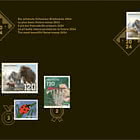- Home
- Stamps
- Switzerland
- 2024
Giants of the Ice Age
Mammoths in Switzerland
What was Switzerland like when mammoths still lived here? The “Giants of the Ice Age” stamp designs invite you to take a journey back in time to the prehistoric animal kingdom. A mammoth expert gives us his insights.
There is evidence of the existence of these long-haired heavy- weights at around 100 locations in the valleys of the Swiss plateau and Jura mountains. They lived where the glaciers re- ceded during the warmer periods of the Ice Age, giving way to
a grassy steppe – the ideal environment for mammoths. One of the richest archaeological sites in Switzerland is Niederweningen (ZH), home of the Mammoth Museum dedicated to the history of these giants. In this interview, the museum’s scientific advisor Heinz Furrer tells us how mammoths and humans coexisted – and challenges a long-held myth.
Heinz Furrer, is it just a feeling or are mammoths the stars of the Ice Age?
Mammoths were the biggest animals in Europe during the Ice Age. Their appearance is imposing. They also generate huge enthusiasm in our museum. Every child is familiar with images of how the tousled giants are portrayed in the animated film Ice Age – as our shaggy friends.
Does this match the character of the mammoth?
Mammoths are often seen as large, long-haired elephants. This is actually quite an accurate picture, as the two are related. We can deduce some of their character traits: for example,
mammoths were probably also intelligent animals that lived in families.
And how did humans get along with them?
The woolly mammoth migrated to Central Europe around 250,000 years ago. Finds show that the animals, adapted to
cold climates, lived in the same landscape as the Neanderthals, and later Homo sapiens, that is to say modern humans. However, there is little archaeological evidence that humans actually actively hunted mammoths.
Is that just a myth?
That’s a matter of debate among the experts. One assump- tion is that humans were capable of cornering and killing mammoths. In my view, that seems unlikely. Bringing down a mammoth – standing three-and-a-half metres tall, and with thick fur and a layer of fat – using a wooden spear with a stone tip is an extremely dangerous undertaking. I think that people used the carcasses of injured or sick animals to make tools or clothing. For meat, they hunted smaller prey, such as red deer, wild boar or hares.
What else are mammoth researchers looking into?
As research evolves, it is yielding frequent new findings. Today, scientists are focusing mainly on DNA analysis, for example to investigate the relatedness of mammoths in Switzerland, Central Europe, Siberia and North America. In Japan and the United States, attempts to clone mammoths have also been underway for many years now, though without success to date. As I see it, however, it would make far more sense to invest efforts into saving animals from extinction.
WOPA+ recommended stamp issues
| Music Giants VII - Iron Maiden |
| Issued: 12.01.2023 |
| ›Great Britain |
| Effigy of H.S.H Prince Albert II - Green Letter Rate |
| Issued: 03.01.2023 |
| ›Monaco |
| Year of the Rabbit |
| Issued: 05.01.2023 |
| ›Guernsey |
| Dimitrie Cantemir, 350th Anniversary of his Birth |
| Issued: 16.01.2023 |
| ›Romania |
| Medicinal Plants |
| Issued: 03.01.2023 |
| ›Romania |
| Honour Guard of the President of the Slovak Republic |
| Issued: 02.01.2023 |
| ›Slovakia |
| Veteran Tractors |
| Issued: 04.01.2023 |
| ›Aland Islands |
| St. Elizabeth’s Church in Parnu |
| Issued: 06.01.2023 |
| ›Estonia |



























